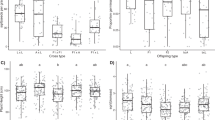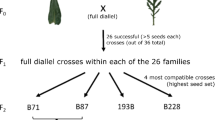Abstract
It is commonly observed that if the genetic divergences between parental lineages are too marked, the intermixed offspring might not be successful or might present reduced fitness, i.e., hybrid inferiority. In the present study, we performed an intraspecific hybridization using two populations of the Asian corn borer, Ostrinia furnacalis: a southern population (S) from Huizhou city (23.09°N, 114.4°E) and a northern population (N) from Harbin city (44.9°N, 127.2°E). The key life-history traits were compared between the two populations with geographical reproductive isolation and their two hybrid populations (S♀ × N♂ and N♀ × S♂ populations) at 20, 24, 28 and 32 °C. Our results showed that there were significant differences in life-history traits in the two parental populations, with the S population performing better. However, the two hybrid populations exhibited delayed larval development time, relatively reduced body weight, lower growth rate and sex ratio distortion compared with their parents. Our results provided further evidence that intraspecific hybridization between the two geographical populations reduced the fitness of the hybrids. The sexual size dimorphism was also different between the pure populations and the hybrid populations. We also found that the sex ratios in the two hybrid populations were mainly influenced by the genotype of the mothers. The negative effects of intraspecific hybridization on the key life-history traits may provide a genetic means of pest management to suppress pest populations.





Similar content being viewed by others
References
Abouheif E, Fairbairn DJ (1997) A comparative analysis of allometry for sexual size dimorphism: assessing Rensch’s rule. Am Nat 149:540–562
Atkinson D, Sibly RM (1997) Why are organisms usually bigger in colder environments? Making sense of a life history puzzle. Trends Ecol Evol 12:235–239
Barton M, Sunnucks P, Norgate M, Murray N, Kearney M (2014) Co-Gradient variation in growth rate and development time of a broadly distributed butterfly. PLoS ONE 9:1–8
Benvenuto C, Cheyppe-Buchmann S, Bermond G, Ris N, Fauvergue X (2012) Intraspecific hybridization, life history strategies and potential invasion success in a parasitoid wasp. Evol Ecol 26:1311–1329
Bergerard J (1976) Sur les rnécanismes possibles de l’action de la température sur la différentiation sexuelle chez les inscctes. Bull Soc Zool Fr 101:39–45
Bidau CJ, Martía DA (2007) Dichroplus vittatus (Orthoptera: Acrididae) follows the converse to Bergmann’s rule although male morphological variability increases with latitude. B Entomol Res 96:69–79
Burke JM, Arnold ML (2001) Genetics and the fitness of hybrids. Annu Rev Genet 35:31–52
Chown SL, Gaston KJ (2010) Body size variation in insects: a macroecological perspective. Biol Rev 85:139–169
Chown SL, Scholtz CH, Klok CJ, Joubert FJ, Coles KS (1995) Ecophysiology, range contraction and survival of a geographically restricted African dung beetle (Coleoptera: Scarabaeidae). Funct Ecol 9:30–39
Conover DO, Present TMC (1990) Countergradient variation in growth rate: compensation for length of the growing season among Atlantic silversides from different latitudes. Oecologia 83:316–324
Conover DO, Schultz ET (1995) Phenotypic similarity and the evolutionary significance of countergradient variation. Trends Ecol Evol 10:248–252
Dai ZY, Qin QL, Yang YZ, Huang DL (2000) The effects of some factors on the diapause induction of the Asian corn borer (Ostrinia furnacalis). Acta Ecol Sin 20:620–623 (in Chinese)
Davidowitz G (2008) Population and environmental effects on the size-fecundity relationship in a common grasshopper across an aridity gradient. J Orthopt Res 17:265–271
Du ZW, Cai WQ (1964) A preliminary report on photoperiodic response of the Asian corn borer, Ostrinia furnacalis (Guenée) in Jiangsu. Acta Entomol Sin 13:129–132 (in Chinese)
Fischer K, Fiedler K (2000) Sex-related differences in reaction norms in the butterfly Lycaena tityrus (Lepidoptera: Lycaenidae). Oikos 90:372–380
Fox CW, Savalli UM (1998) Inheritance of environmental variation in body size: superparasitism of seeds affects progeny and grandprogeny body size via a nongenetic maternal effect. Evolution 52:172–182
Fu S, Chen C, Xiao L, He H, Xue F (2015) Inheritance of Diapause in Crosses between the Northernmost and the Southernmost Strains of the Asian Corn Borer Ostrinia furnacalis. PLoS ONE 10(2):e0118186
Fu DM, He HM, Zou C, Xiao HJ, Xue FS (2016) Life-history responses of the rice stem borer Chilo suppressalis to temperature change: breaking the temperature-size rule. J Therm Biol 61:115–118
Gong HF, Chen P, Wang R, Lian ML, Xia ZH, Yan Y (1984) The influence of photoperiod and temperature on the diapause of the Asian corn borer Ostrinia furnacalis (Guenée). Acta Entomol Sin 27:280–286 (in Chinese)
Gotthard K, Nylin S, Wiklund C (1994) Adaptive variation in growth rate: life history costs and consequences in the speckled wood butterfly, Pararge aegeria. Oecologia 99:281–289
Guo JQ, Zhang HG, Wang ZY, He KL (2013) Effects of photoperiod and temperature on diapause induction in Ostrinia furnacalis (Lepidoptera: Crambidae). Acta Entomol Sin 56:996–1003 (in Chinese)
Honek A (1993) Intraspecific variation in body size and fecundity in insects—a general relationship. Oikos 66:483–492
Huang LL, Chen C, Xiao L, Xia QW, Hu LT, Xue FS (2013) Geographical variation and inheritance of the photoperiodic response controlling larval diapause in two distinct voltine ecotypes of the Asian corn borer Ostrinia furnacalis. Physiol Entomol 38:126–132
Ichiki R, Takasu K, Shima I (2003) Effects of temperature on immature development of the parasitic fly Bessa parallela (Meigen) (Diptera: Tachinidae). Appl Entomol Zool 38:435–439
Kageyama D, Hoshizaki S, Ishikawa Y (1998) Female-biased sex ratio in the Asian corn borer, Ostrinia furnacalis: evidence for the occurrence of feminizing bacteria in an insect. Heredity 81:311–316
Kivelä SM, Välimä P, Carrasco D, Maenpaa MI, Oksanen J (2011) Latitudinal insect body size clines revisited: a critical evaluation of the saw-tooth model. J Anim Ecol 80:1184–1195
Kutcherov D (2016) Temperature effects on the development, body size, and sex ratio of the walnut leaf beetle Gastrolina depressa (Coleoptera: Chrysomelidae). J Asia-Pac Entomol 19:153–158
Liu N, Wen LP, He KL, Wang ZY, Zhao TC (2005) The cold hardiness in the different geographic populations of Asian corn borer, Ostrinia furnacalis (Guenée). Acta Phytophylacica Sin 32:163–168 (in Chinese)
Lovich JE, Gibbons JW (1992) A review of techniques for quantifying sexual size dimorphism. Growth Dev Aging 56:269–281
Lu X, Li JP, Wang YS (1995) Preliminary study on voltinism types of Ostrinia furnacalis (ACB). J Maize Sci 3:75–78 (in Chinese)
Ma R, Qian HT, Dong H, Xia X, Cong B (2008) Research on the development period of over-wintering larvae of different geographic populations of Asian corn borer. Hubei Agric Sci 47:541–543 (in Chinese)
Margolies DC, Wrench DL (1996) Temperature-induced changes in spider mite fitness: offsetting effects of development time, fecundity, and sex ratio. Entomol Exp Appl 78:111–118
Masaki S (1967) Geographic variation and climatic adaptation in a field cricket (Orthoptera Gryllidae). Evolution 21:725–741
Miyahara Y (1984) Abnormal sex ratio in Ostrinia furnacalis Guenée (Lepidoptera: Pyralidae). Jap J Appl Ent Zool 28:131–136 (in Japanese with English summary)
Moiroux J, Brodeur J, Boivin G (2014) Sex ratio variations with temperature in an egg parasitoid: behavioural adjustment and physiological constraint. Anim Behav 91:61–66
Mousseau TA (1997) Ectotherms follow the converse to Bergmann’s Rule. Evolution 51:630–632
Nylin S, Gotthard K (1998) Plasticity in life-history traits. Annu Rev Entomol 43:63–83
Ode PJ, Hardy ICW (2008) Parasitoid sex ratios and biological control. In: Wajnberg E, Bernstein C, van Alphen JJM (eds) Behavioral ecology of insect parasitoids, from theoretical approaches to field applications. Blackwell, Oxford, pp 92–112
Parsons PA, Joern A (2014) Life history traits associated with body size covary along a latitudinal gradient in a generalist grasshopper. Oecologia 174:379–391
Qiao L, Zheng JW, Cheng WN, Li YP (2008) Impact of 4 different artificial fodders on life span of Asian corn borer, Ostrinia furnacalis (Guenée). J Northwest A&F Univ 36:109–112 (in Chinese)
Reinhold K (1994) Inheritance of body and testis size in the bushcricket Poecilimon veluchianus Ramme (Orthoptera; Tettigoniidae) examined by means of subspecies hybrids. Biol J Linn Soc 52:305–316
Roff DA (1980) Optimizing development time in a seasonal environment: the “ups and downs” of clinal variation. Oecologia 45:202–208
Roy M, Brodeur J, Cloutier C (2003) Temperature and sex allocation in a spider mite. Oecologia 135:322–1326
Shen RW, Xue FS, Zhu XF (1988) Studies on voltinism and the date of diapause incidence in the Asian corn borer, Ostrinia furnacalis (Guenée) in the field. Jiangxi Plant Protection 1:18–19 (in Chinese)
Sibly RM, Calow P (1986) Why breeding early is always worthwhile. J Therm Biol 123:311–319
Tang J, He H, Chen C, Fu S, Xue F (2017) Latitudinal cogradient variation of development time and growth rate and a negative latitudinal body weight cline in a widely distributed cabbage beetle. PLoS ONE 12(7):e0181030
Wang ZY, Lu X, He KL, Zhou DR (2000) Review of history, present situation and prospect of the Asian maize borer research in China. J Shenyang Agric Univ 31:402–412 (in Chinese)
Wilkes A (1959) Effects of high temperatures during postembryonic development on the sex ratio of an arrhenotokous insect, Dahlbominus fuliginosus (Nees) (Hymenoptera: Eulophidae). Can J Genet Cytol 1:102–109
Xia QW, Chen C, Tu XY, Yang HZ, Xue FS (2012) Inheritance of photoperiodic induction of larval diapause in the Asian corn borer Ostrinia furnacalis. Physiol Entomol 37:185–191
Xiao L, He HM, Zhong PS, Fu S, Chen C, Xue FS (2015) Inheritance of photoperiodic control of larval diapause in the Asian corn borer Ostrinia furnacalis (Guenée). B Entomol Res 105:326–334
Xiao L, He HM, Huang LL, Geng T, Fu S, Xue FS (2016) Variation of life-history traits of the Asian corn borer, Ostrinia furnacalis in relation to temperature and geographical latitude. Ecol Evol 6:5129–5143
Xie HC, Li DS, Zhang HG, Mason CE, Wang ZY, Lu X, Cai WZ, He KL (2015) Seasonal and geographical variation in diapause and cold hardiness of the Asian corn borer, Ostrinia furnacalis. Insect Sci 22:578–586
Yang HZ, Tu XY, Xia QW, He HM, Chen C, Xue FS (2014) Photoperiodism of diapause induction and diapause termination in Ostrinia furnacalis (Lepidoptera:Crambidae). Entomol Exp Appl 153:34–46
Zhou DR, He KL (1995) Asian corn borer and its integrated management. Golden Shield Press, Beijing
Acknowledgements
We thank Dr. Shaohui Wu from the Department of Entomology at the University of Georgia (Tifton, GA) for providing critical comments and polishing the language of the manuscript. The research was supported by a grant from the National Natural Science Foundation of the People’s Republic of China (31560608).
Author information
Authors and Affiliations
Corresponding authors
Ethics declarations
Conflict of interest
The authors declare that they have no conflict of interest.
Human and animals
This article does not contain any studies with human participants or animals (vertebrates) performed by any of the authors.
Informed consent
Informed consent was obtained from all individual participants included in the study.
Additional information
Communicated by M. Traugott.
Publisher's Note
Springer Nature remains neutral with regard to jurisdictional claims in published maps and institutional affiliations.
Electronic supplementary material
Below is the link to the electronic supplementary material.
Rights and permissions
About this article
Cite this article
He, H., Tang, J., Huang, L. et al. Inter-geographic hybridization in the corn borer Ostrinia furnacalis reduced the fitness of hybrids. J Pest Sci 92, 1027–1037 (2019). https://doi.org/10.1007/s10340-019-01119-3
Received:
Revised:
Accepted:
Published:
Issue Date:
DOI: https://doi.org/10.1007/s10340-019-01119-3




